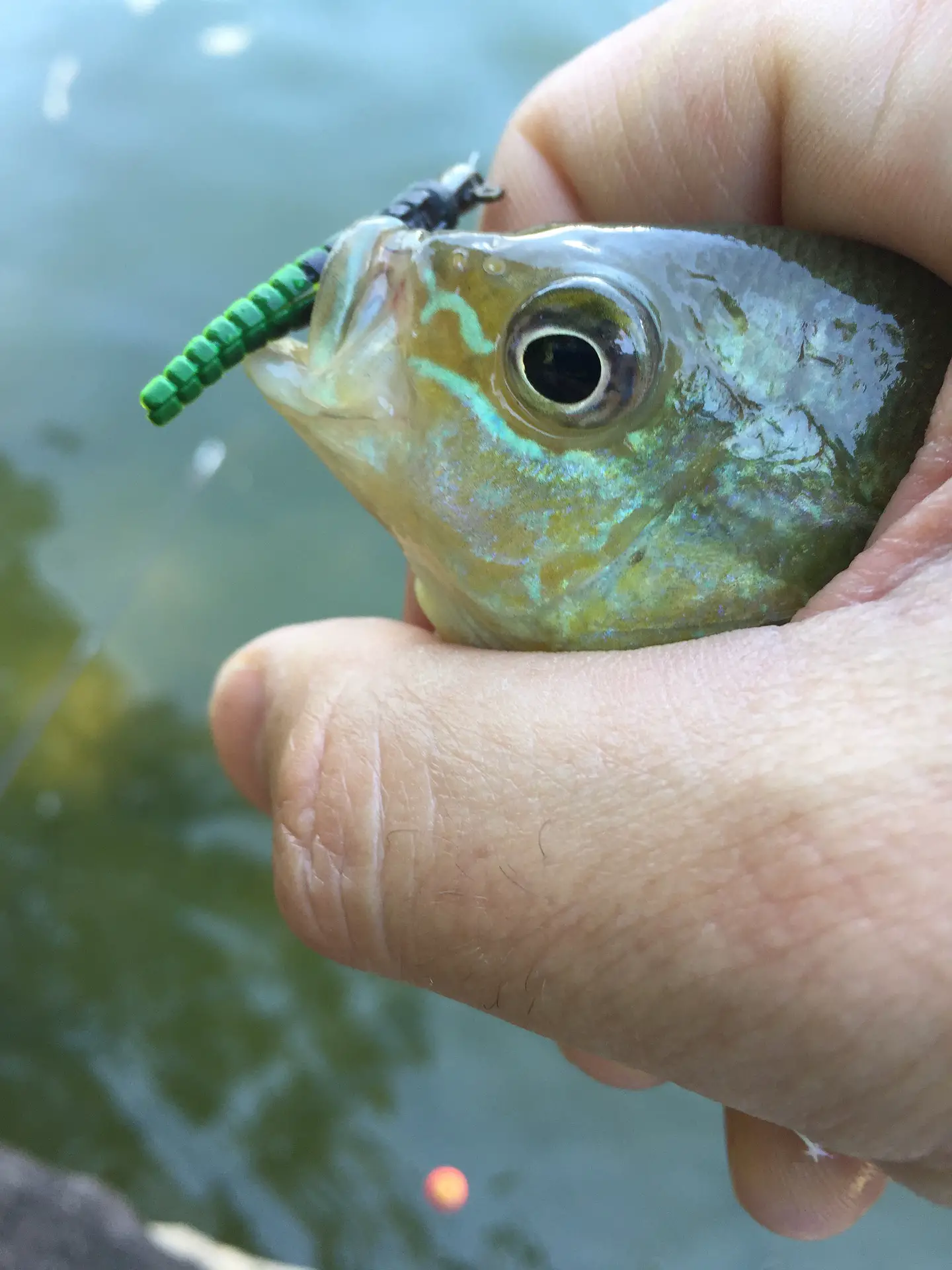Two of the most highly sought after but often misidentified panfish are the redear sunfish and the bluegill. The two fish are widely distributed in freshwater lakes, rivers, creeks, and ponds through Georgia, South Carolina, and North Carolina. Despite the small size of each, they are excellent fighters. It is essential to know the differences between the redear sunfish vs bluegill when you are out catching fish.
Redear Sunfish
The redear is identified by a unique marking and is excellent for both experienced and inexperienced anglers to target when fishing. Here is what to know about the redear sunfish.
How Do You Identify A Redear Sunfish
The redear sunfish is identified by a red marking on the gill plate’s upper back section, hence the name redear. The sides contain vertical bars and are spotted with black and red dots above olive-colored skin.
How Big Do Redear Sunfish Grow
On average, the redear measures between seven and ten inches, weighing less than a pound. However, anglers hook into a brute, occasionally measuring over sixteen inches and pushing into the two-pound range. When comparing red ear sunfish vs bluegill the red ear grows larger in size.
What Is The Range Of A Redear Sunfish
Redear sunfish are native to the southeastern portions of the United States from Georgia to Texas. The fish extended down through Florida and into Illinois and Kentucky.
Today, redear are scattered about fresh bodies of water across the US as stocking programs have introduced them.
What Is The Habitat Of A Redear Sunfish
The redear is found in rivers, creeks, lakes, and ponds near structures including logs, lily pads, swampy wetlands, and other aquatic vegetation in deep water with little to no flow.
How Do You Catch Redear Sunfish
Redear sunfish are equipped with small mouths; therefore, hooks and lures must also be small. Utilizing oversides tackle results in missing fish frequently.
Artificials
Unfortunately, redear sunfish do not readily strike artificial baits. Occasionally redears bite small spinners and jigs when reeled slowly. This is a primary difference between sunfish vs bluegill.
Live Bait
Live bait is a necessity. Purchase crickets, wax worms, or mealworms from a local bait and tackle shop. Add a small bobber to the mainline with a hook attached below. Rig the redear sunfish bait and cast near structure or fish along the bottom.
Are Redear Sunfish Good To Eat
The redear sunfish is excellent when filleted and prepared. One benefit to redear sunfish is the size. The redear is larger; therefore, it yields more substantial fillets.
Anglers describe the fillets as sweet and mild but flaky when cooked. Prepare the fish by breading and frying, seasoning and broiling, or grilling in tin foil.
Bluegill
Bluegill is likely the most well-known panfish to anglers because of the delicious fillets that the fish produce. Here is what you need to know about bluegill vs redear.
How Do You Identify A Bluegill
The following markings identify the bluegill. A black spot is positioned at the rear upper portion of the gill plate and the rear lower portion of the dorsal fin. The sides of the fish are marked with vertical bars extending from the base of the dorsal fin to the belly. Lastly, hence the name, the gill section is blue.
How Big Do Bluegill Grow
When it comes to size, the bluegill is most frequently caught between seven and eight inches in length but does exceed fifteen inches.
Bluegill measuring seven to eight inches weighs eight ounces. A fourteen-inch bluegill tips the scale at over two pounds. Don’t expect a heavyweight battle.
What Is The Range Of A Bluegill
The bluegill is widely distributed across the United States. To the west, anglers catch bluegill in New Mexico. Florida’s freshwater lakes are prevalent with the fish to the south. Lastly, they extend up the east coast, through the midwest, and into Canada.
The range of the bluegill is expansive, making them a prime target in nearly every state, including Georgia, South Carolina, and North Carolina.
What Is The Habitat Of A Bluegill
The bluegill enjoys seeking shade. When seeking bluegill, focus on trees casting a shadow over the water, docks, and beneath vegetation. Other areas of concentration include islands beneath the surface, channels, and weed beds. Both the bluegill vs sunfish prefer areas with minimal water flow.
How Do You Catch Bluegill
When focusing your attention on bluegill, most critical is to avoid oversides hooks, rod and reel combinations, and line weight. Always use a lightweight spinning rod and reel combination.
Bluegill are aggressive feeders willing to strike both live and artificial baits. Use these techniques when fishing with artificials or live bait. When comparing bluegill vs redear sunfish the redear prefers live bait only.
Artificials
When selecting lures, the number one choice is hair jigs. The second best option is spinner blades off the edge of weedy shorelines. Lastly, imitation minnow lures, when presented slowly, are highly effective. Remember, no matter which lures you choose, they must be small in size. The difference between bluegill and sunfish is that if you’re fishing with jigs for redear the hook must be tipped with live bait.
Live Bait
Live bait is the best option for young anglers. Place a float above a small hook with baits, including wax worms, crickets, or nightcrawlers. Cast beneath the shade or near cover. Reel the fish in once the bobber dips below the surface. Repeat the process continuously.
Are Bluegill Good To Eat
When it comes to taste and texture, bluegill fillets are described as sweet, firm, and flaky when cooked.
The firmness of the fillets allows the fish to be prepared in many methods. The most popular cooking methods include deep frying, sauteing on the stove, or broiling.
Remember, the yield per fish is minimal; therefore, multiple fish are required to feed a family or group of friends. This is especially true when comparing redear vs bluegill fillets. Lastly, the fillets are thin, so it is essential to avoid overcooking them as they quickly become dry.
Now You Know The Difference Between Redear Sunfish And Bluegill
When it comes to identifying the red ear sunfish vs. bluegill the differences are subtle. Key markings assist in determining which fish is which. No matter which fish you catch, they are fun battlers on light tackle and offer excellent table fare. Bring out the whole family when targeting panfish and teach everyone the differences between redear sunfish vs bluegill.




